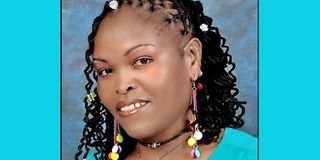Weep not child, mama is here

Hellen Gathogo left work as a programme manager to rescue young girls suffering from forced abortions. PHOTO| COURTESY
What you need to know:
- Once beaded, the five-year-old is handed over to a mature relative who 'protects' her from other men.
- We were so poor that the poor called us poor.
- Luckily the community educated me up until university level through 'harambees'.
- The plight of the little girls back home would not give me peace.
- I'm a co-founder and executive director of One More Day for Children Foundation
"I am a social worker, paralegal and counsellor. I have two children, a girl in university and a boy in high school. I come from Laikipia North, an area that is notorious for female genital mutilation (FGM), early marriages and beading.
These are practices that are very rampant among the Samburu and Maasai communities and even though I do not come from these communities, my heart bleeds, especially for the beaded girls.
The Samburu men explained to me that the little girls were beaded to 'protect' them from male harassment in the community as well as recognition of beauty in exchange for sex. What! Sex at that age? I looked and sympathised as they were denied the right to be children and instead, becoming child mothers.
Beading is a practice that is held close to the girl's hearts as it symbolises that they are beautiful. Girls who are not beaded are perceived as ugly. Girls as young as five are allowed to have a 'boyfriend' who has to be a relative. He then buys special beads for his 'girlfriend' and puts them around her neck to mark his territory.
Once beaded, the five-year-old is handed over to a mature relative who 'protects' her from other men. Unfortunately, as these girls get to adolescence, they conceive since they are exploited sexually. Then they are forced to abort since the children sired by the 'protectors' are regarded a bad omen, seeing as the protector is a relative. If they give birth, the babies are killed at birth.
AGAINST ALL ODDS
I grew up in abject poverty. In fact, I always say that if someone wanted to conduct research on poverty, they would have successfully conducted it in our home. We were so poor that the poor called us poor.

Hellen Gathogo with Samburu children. PHOTO| COURTESY
Ours was a large family of 11, eight girls and three boys, which was plagued with teenage pregnancies, prostitution and school drop-outs. None of my siblings could stand up to be counted. Fortunately for me, I was top in my class when I did my certificate of primary education (CPE), which was my salvation as people came together to raise funds for my high school.
Dad was a night watchman and could not afford to educate me. Luckily the community educated me up until university level through 'harambees'. Deep down, I craved to bring a difference in my community.
I graduated and worked for different organisations but I never forgot the beading practice I witnessed.
The plight of the little girls back home would not give me peace. As a programme manager at an NGO, I would reach out to the abused girls but in a small capacity. As I got to interact with these girls, I found out the intensity of what they were going through.
They explained to me how the crude abortions were carried out: The older women would literally kneel on the little girls’ bellies as they squeezed them to get rid of the foetus. They would also insert herbs in their tiny birth canals and feed the girls with lots of sheep fat to cause diarrhoea, which was believed to aid in expelling the foetus.
I worked for a few years but felt it was limiting me as my employer was strict on boundaries and nature of abuses. I felt I wasn't doing enough (for the girls).
GIVING BACK
I quit work and embarked on consultancy work in Nairobi, specialised on child right and protection, gender-based violence, adolescent sexual and reproductive rights and child participation. I went back home in 2009 and decided to realise my dream of rescuing abused girls. My community had come through for me as a young girl, now it was my turn to come through for them.
I'm a co-founder and executive director of One More Day for Children Foundation, an organisation that rescues young abused girls from different communities. The national Government allocated us 13 acres of land where we put up facilities to accommodate the children through 'harambees' and well-wishers.
To date we have been able to rescue over 2,000 girls and some have made it to university. We try and reconcile them with their families when they are healed but we ensure that the conflict is over before re-uniting them.
I have girls in my care as young as nine and 10 years who have babies. These are the ones who have managed to successfully escape after falling pregnant, and most of them are infected with candidiasis. The girls stay with us for about two weeks then we send them to school. I work closely with the Ministry of Education, who appointed me as Vice Chairman of the County Education Board. This way, we ensure the kids get a good education.
I'm also a member of the Court Users Committee and use the forum to champion for the children's rights and justice.
Yes, education is free but unfortunately, it is inaccessible for most of the girls who have to traverse long distances before getting to school. If they don't encounter human beasts who prey on their innocence, they are busy dodging wild animals.
The progress is gradual and I hope to see a community that gives the girl-child a fighting chance, and where punitive measures can be taken against these atrocities.”





